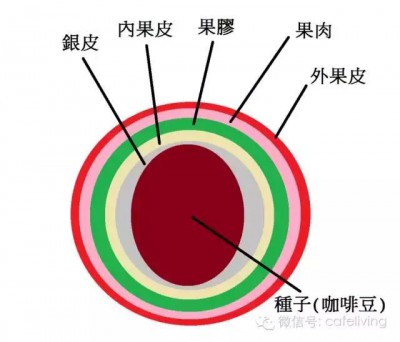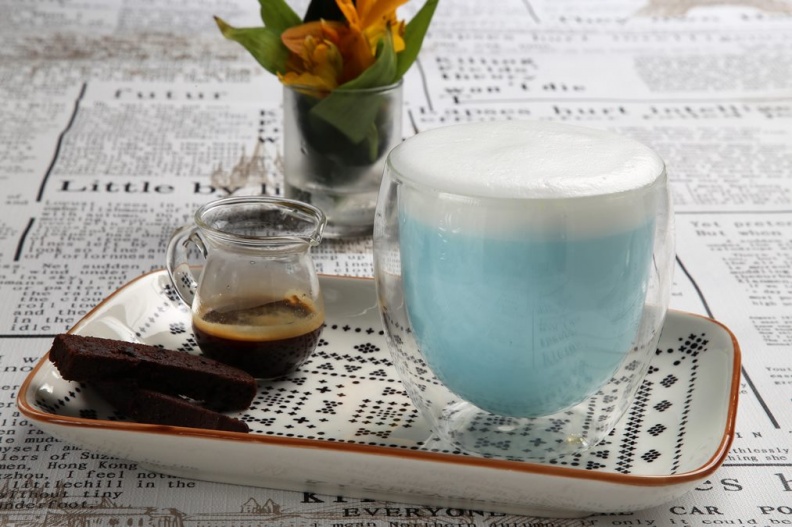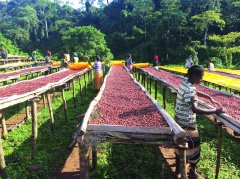What are the treatment methods for coffee beans? the five most common ways to treat raw coffee beans

Professional coffee knowledge exchange more coffee bean information please follow the coffee workshop (Wechat official account cafe_style)
The four most common processing methods of Brazilian coffee
When it comes to the treatment of raw coffee beans, first of all, we have to talk about how coffee comes from.
Coffee trees from seedlings to blossom, and finally bear fruit, is the origin of coffee.
Coffee fruit, also known as coffee cherry, coffee beans are the seeds of coffee cherries.
After the coffee cherry is picked from the tree, the exocarp pulp and pectin are removed, a process called raw bean treatment.
Raw coffee beans are treated in different ways, and they largely determine the taste and quality of coffee!
Today we will talk about the advantages and disadvantages of each major treatment method! Hurry up and collect it--
Solarization method
The strong aroma of wine is exposed to the sun.
This is the most primitive, simple and oldest treatment of coffee. According to relevant literature, Arabs began to treat the fruits of coffee by tanning as early as 1000 years ago in the 11th century.
Treatment process
First pour the coffee beans into a large tank, the underdeveloped inferior beans will float on the surface, pick up the ripe and full fruits that sink to the bottom of the water, lay them in the sun, and often turn them over to pick out defects.
When the water content in the coffee beans is reduced to 10%-14%, the peel pectin can be knocked off with a sheller, and the whole solarization method is complete.
Shortcoming
The sun method depends entirely on the weather, and the dryness of coffee fruit is difficult to control. If the sun is not clean, it is easy to mix with impurities. In the process of the sun, the pulp of the coffee fruit has not been removed, so it is often moldy and rotten. Therefore, in the view of many people, the quality of sun-exposed coffee beans is not controllable and the level is not too high.
Advantages
Except for the first step of using water to filter out shoddy beans, the other steps no longer need any water, and can be used repeatedly. In areas where water resources are not abundant, this method is simply awesome.
And because sun-dried beans have irreplaceable special flavor, some excellent farms begin to take sun-dried beans seriously, such as putting them on shelves to prevent pollution and fine selection, so today we can see a lot of high-quality sun-dried coffee beans.
Flavor
Although the sun-cured beans are uneven in appearance and different in color, because the coffee beans ripen naturally inside the fruit and are not disturbed by the external environment, the sun-cured coffee beans have a stronger flavor, wine-like fermented taste and sweet taste.
Washing method
Wash with water to give a clean sour smell.
Because of the shortcomings of the solarization method, the Dutch invented the washing method in the mid-18th century, which was widely favored. The biggest difference from the sun method is that it uses fermentation to remove the skin.
Treatment process
As in the first step of the sun method, remove the shoddy beans, then use the pulping machine (pulp planer) to remove the peel and pulp of the coffee fruit, throw it into the sink and ferment for 16-36 hours, and the fermentation bacteria dissolve the pectin.
In order to remove the residue of fermentation bacteria and impurities, the coffee beans are washed again, and then the coffee fruit is dried by machine to reduce the moisture content to 10% Murray 14%. Finally, the use of shelling machine to remove the silver skin on the coffee beans can be completed.
Shortcoming
Water washing, as its name implies, mostly requires water, but it is unlikely to be adopted in some countries that lack water resources. The process of washing is also relatively cumbersome and the cost is much higher than that of tanning.
Advantages
After layers of screening and cleaning, the appearance and taste will be cleaner and more uniform. And because the flesh is removed in the first place, you don't have to worry about mildew as much as the sun.
Flavor
Washed beans usually have bright and clean acidity because they ferment acid in the fermentation tank.
Semi-washing method
Beat by half-washing method, and all the pectin in the peel will be knocked out.
Because the water washing method requires too much water, the semi-washing method was born out of thin air. It is a mixture of sun exposure and water washing, and it is also a compromise between the two.
Treatment process
First, it is the same as the above two treatments, first remove the shoddy beans; then pour the coffee fruit into the pulping machine (pulp planer) to remove the peel and pulp.
In order to reduce water consumption, semi-washing uses demucilager (pectin scraper) to remove pectin, and finally the coffee fruit is dried or exposed to outdoor exposure.
Reduce the water content of the coffee fruit to 10% Murray 14%, and then use the sheller to remove the silver skin sticking to the coffee beans, that is, complete!
Np800034roqq318o1q9
Shortcoming
Although it is a mixture of washing and tanning, its process is as tedious as washing.
Advantages
With the cleanliness of the washing method, it does not need to consume a lot of water.
Flavor
The semi-washing method had the least influence on the quality, and the sour taste of coffee was lower than that of washed beans and higher than that of sun-washed beans; the sweet taste was lower than that of honey treatment, but the cleanliness was better than that of honey treatment, and the flavor was between honey treatment and water washing.
Honey treatment method
Honey treatment honey, pectin honey produces sugar
Honey treatment (Miel Process in Spanish) is also called half-sun treatment. It is the most fashionable and characteristic treatment in recent years, and the main difference between it and the sun method is whether the pulp is removed before or after the sun.
Treatment process
Similarly, the first step is still to remove the shoddy beans, and then through the pulping machine (pulp planer), remove the skin and pulp, and then sun, so that the water content of the coffee fruit is reduced to 10% Mel 14%.
Finally, you can use the sheller to remove the silver skin sticking to the coffee beans.
Shortcoming
Among the several mainstream ways of handling coffee beans, it is the most complex and painstaking.
Advantages
It belongs to the improved method of tanning, which effectively changes the problem of mildew of coffee beans and reduces the cost of water.
Flavor
Because it is sunburned with pectin, the sugar in the pectin enters the beans during the drying process, making the coffee beans sour and sweet balanced and mellow. In recent years, the winners of many competitions have come from the honey treatment process, which is quite famous in Costa Rica.
Fermentation (in vivo fermentation of civets)
The animal ferments and eats, pulls out the gentle mellow fragrance
With regard to animal fermentation, the editor personally thinks it is extremely cruel, the most typical of which is civet coffee (Kopi Luwak).
Principle:
The lactic acid bacteria and digestive juices in the digestive tract of animals are used to remove the pectin from the pulp and the surface of the pods. The beans are excreted with the feces, and after cleaning, they are precious grains of fermented beans in the body. In addition to the civets, there are also Phoenix-crowned pheasants, monkeys and elephants in fermented beans in animals, but none of the latter have formed a scale, only civets stand out.
At first, it was because the musk cat haunted at night, relying on its eyesight and sense of smell, chose the reddest coffee fruit to eat, and was not interested in the half-unripe fruit, so the beans excreted were all ripe and well-ripe. These fecal beans are washed and then baked, killing all bacteria. The most important feature is that the flavor is gentle and the taste is doubled, while the fundamental flavor depends on the variety of coffee eaten by the civet.
In New York, a pound of civet coffee costs $500, while in Hong Kong, a cup of civet costs $50. Later, people discovered this business opportunity and began to raise civets in large quantities and keep feeding coffee beans, thus producing more Kopi Luwak for profit.
Treatment form
In fact, different producing areas will "adjust measures to local conditions", using the most appropriate way of fruit treatment, a coffee bean comes to your cup, coffee farmers should not only consider the cost, but also what kind of treatment this coffee fruit is suitable for. Make its flavor more prominent and delicious.
.
Important Notice :
前街咖啡 FrontStreet Coffee has moved to new addredd:
FrontStreet Coffee Address: 315,Donghua East Road,GuangZhou
Tel:020 38364473
- Prev

Taiwan coffee shop four most creative coffee-conquer your imagination with your appearance!
Professional coffee knowledge exchange more coffee bean information please follow the coffee workshop (Wechat official account cafe_style) 3 minutes to become coffee talent, learn to make the most famous coffee creative coffee around the world to provide coffee another kind of fun to drink, there is a sense of surprise, but also impressive appearance or flavor combination, more important is to test the barista's understanding of ingredients and
- Next

Coffee treatment: what are the kinds of sun treatment? What's the difference between the sun and the half-sun?
Professional coffee knowledge exchange more coffee bean information please pay attention to the coffee workshop (Wechat official account cafe_style) the four most common ways to handle Brazilian coffee good handling methods can lead to the rich flavor of coffee. Just as wine needs to be well brewed to produce a wine with excellent flavor, so the treatment for raw beans is similar, and different treatments will produce
Related
- What is the meaning of lactic acid fermentation with coffee bean treatment?
- How to judge the state of foam by sound?
- How does the latte pull out the unicorn pattern? Come to get for a little trick to improve the flower pull!
- Will flower pulling affect the taste of the latte?
- Do you know the history of coffee?
- The difference between honey treatment and sun washing what is raisin honey treatment?
- What kind of milk can a novice use to make coffee foam to keep the foam longer? The correct method and skills of milking tutorial sharing
- Why do washed coffee beans taste sour? Flavor characteristics of washed Coffee
- Introduction to the skill of how to practice the size and height of water injection around the circle of hand-brewed coffee
- How do beginners practice coffee flower drawing from scratch?

